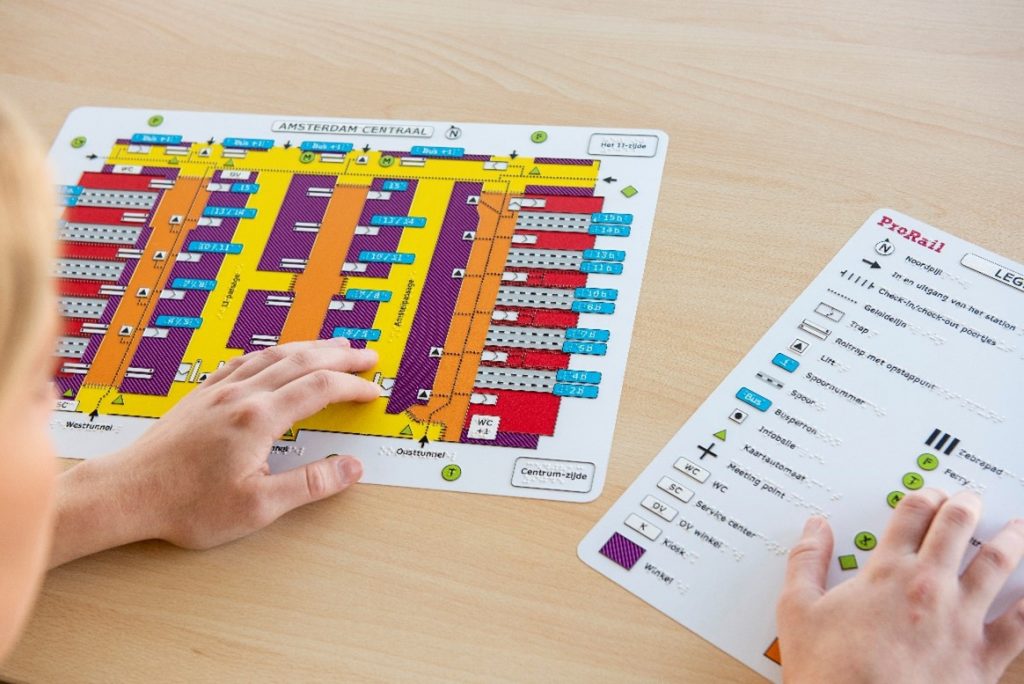In 2008 the Dutch ministry of Infrastructure approved a plan to make all stations accessible for people with a disability. Since then ProRail is making an average of twenty stations a year accessible by creating step free routes with the construction of lifts and ramps. We bring platforms to the correct height so that travelers can board the train by themselves. For the blind and visually impaired we create obstacle free and tactile routes through every station and adding braille signs on stair banisters and lifts. These are the physical measures which ProRail implements but to make the rail system truly accessible and free of obstacles much more is done.
Nothing about us, without us
The true strength of value of adding accessibility to existing stations is by doing so in a predictable and concise way. To that end ProRail works closely together with the interest groups which represent the persons with different disabilities. Before implementing measures across the network we test or pilot them together. For example the tactile pavement, braille signs and ramps. That way usability and customer satisfaction is ensured
Accessibility at stations
The Netherlands has 400 train stations. Accessibility-wise the picture is the following:
- At 76% of the train stations all accessibility measures have been implemented;
- 97% of the stations are step-free, i.e. all platforms can be reached by lift or ramp;
- All stations have tactile routes and braille signs on stair banisters;
- 315 stations have adjusted platform heights to ensure self-accessibility to modern trains.
By 2022, at least 90% of passengers will be able to travel to and from stations that are completely independently accessible. Before 2030 all stations will be independently accessible.
Strengthening the weakest link
Bram ‘t Mannetje (Programme manager Accessibility at ProRail): “Now that we have been working for years and have adapted so many stations, ProRail can rightly say that an accessible station has become the standard. What we have learned in the past few years is that accessibility is not only achieved by implementing physical measures. Persons with a disability use it only if they know what has been accomplished and know how it works. So things like reliable and real time information about accessible travel possibilities are key. To that end we work closely together with our train operators to provide information with which tailormade travel advise can be given.
But we also equip key accessibility assets like lifts with sensors with which real-time information can be provided to passengers when lifts are out of order and alternative travel options can be offered. And for visual impaired passengers we offer tactile maps of the most complex stations which can be sent to them so that they can familiarise themselves with the station beforehand. It is the mix of realising physical measures and providing reliable information that strengthens the fragile link which accessible travel inherently is. What we see and get as feedback is that all passengers gain by this programme. Not only those with an impairment, but also the young parents with prams and the passengers with bicycles and luggage. We are implementing design for all. Which is such a great thing to implement”
Would you like to know more about how ProRail makes stations accessible to passengers with a functional disability? Then watch the following video 👉https://www.youtube.com/watch?v=j_GTikR0NFE

Since 2008 ProRail is making an average of twenty stations a year accessible by creating step free routes with the construction of lifts and ramps. By 2022, at least 90% of passengers will be able to travel to and from stations that are completely independently accessible. Before 2030 all stations will be independently accessible.

For the blind and visually impaired we created obstacle free and tactile routes through every station.

97% of the stations are step-free, i.e. all platforms can be reached by lift or ramp.

All stations have tactile routes and braille signs on stair banisters and lifts.

For visual impaired passengers we offer tactile maps of the most complex stations which can be sent to them so that they can familiarise themselves with the station beforehand.

